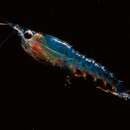ar
الأسماء في صفحات التنقل


Thysanoessa spinifera is an important prey item in the diet of Cassin's Auklet (Ptychoramphus aleuticus) in the Gulf of Farallones, California, USA. Ainley et al. (1996) report that once seasonal upwelling makes T. spinifera available, P. aleuticus relies heavily on this relatively large and energetically valuable euphausiid. They also report a Cassin's Auklet population decline of about 50% coincident with a general decline of zooplankton in the California Current. In general, long term studies through the 1970s and 1980s indicate that variations in upwelling activity have a strong impact on the availability of euphasiids, which in turn strongly impacts Cassin's Auklet populatons (Ainley et al. 1996). Abraham and Sydeman (2006) note that both long-term and short-term changes in prey availability are reflected in the diets of Cassin's Auklets, providing support for the idea that monitoring the diets and reproductive success of top marine predators can be used as an additional tool to monitor the distribution and abundance of forage fishes and zooplankton.
In a study of the feeding habits of the world's largest stock of blue whales (Balaenoptera musculus), near the Channel Islands off southern California, in the summers of 1995 and 1996, the krill species Thysanoessa spinifera and Euphasia pacifica were found to be a major component of the diet of blue whales, with a preference shown for the larger, more coastal E. spinifera (Fiedler et al. 1998). These same two krill species were found to dominate the diets of blue whales foraging in Monterey Bay (central coast of California, USA) (Croll et al. 2005). A blue whale may consume up to two tons of krill each day (Rice 1978, cited in Fiedler et al. 1998).
Thysanoessa spinifera is a common and widespread species of krill, which are small shrimp-like crustaceans occurring in often extremely dense concentrations in all the world's oceans. Adults to 3 cm (Fiedler et al. 1998; Brinton and Townsend 2003).
Thysanoessa spinifera ranges from southeast Alaska to northern Baja California (Brinton 1962, cited in Ainley et al. 1996). A northern cold-water coastal species, it frequently ranged far south off Baja California before 1960, but became limited to Central California in the 1980s (Brinton and Townsend 2003).
Thysanoessa spinifera occurs mostly in waters less than 100 m deep (Brinton 1962, cited in Fiedler et al. 1998), although later life history stages may occur deeper in the water column, e.g. 150-200 m (Croll et al. 2005 and references therein).
Gomez-Gutierrez et al. (2006) reported a newly described species of apostome ciliate, Collinia oregonensis n. sp., inhabiting the cephalothorax and abdomen of 3 euphausiid species from the Oregon-Washington coast, including Thysanoessa spinifera. Collinia oregonensis must kill its host to complete its life cycle. Adult euphausiids infected with this parasitoid possess a swollen and bright orange cephalothorax. Given that Thysanoessa spinifera and Euphausia pacifica (which is also infected by this ciliate) together account for about 90% of the euphausiid standing stock in the northern California Current System, this parasitoid ciliate may have a significant impact on euphausiid population abundance, distribution and secondary productivity (Gomez-Gutierrez et al. 2006). This ciliate is the 7th species described for the genus Collinia and the 2nd species known to infect euphausiids. Other apostome ciliates are also known from T. spinifera, such as Gymnodinioides pacifica (Landers et al. 2006 and references therein).